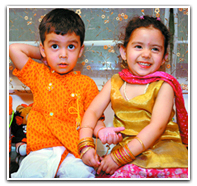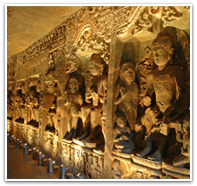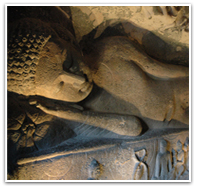India Travel Guidelines
A general guide to ensure you has a pleasant time in India.
- Carry
your passport, other travel documents and your money separately. You don't
want to lose them all together.
- Keep
extra photocopies of the relevant pages of your passport. This is needed
for various reasons in India, at the hotel, to buy a SIM card etc.
- Never
travel without mosquito repellents and other essential medicines. Carry a
doctor’s prescription all the time if you are on specific medication.
- Inform
your tour operator beforehand if you are allergic to a particular
substance or a drug.
- Ensure
that your luggage is waterproof.
- Many women travellers prefer to carry a high pitched whistle that would scare away stalkers.
Clothes:
·
Travel as light as possible. Clothing and laundry
are both affordable in India.
·
It’s better for women to avoid tank tops or short
skirts / shorts.
·
Winters are pleasant in southern India while you
will need heavy woollens as you progress in the Northern region.
·
Summers are harsh throughout, so light cotton
clothes are most comfortable.
·
Best to avoid miniskirts / shorts both for men and
women while visiting temples. Some temples may insist to cover your head as
well. A small handkerchief or a scarf can suffice.
Social Interaction:
·
If you give the impression of being from a different
country, chances are that you might be stared at, especially in the smaller
towns. Don’t be offended-they mean no harm, it is just curiosity.
Toilets:
·
In India, public toilets facilities are few and far
between. Take every opportunity you can to use a clean toilet in places such as
hotels and restaurants. Make this a habit wherever you go.
Beggars:
·
Do not let them hassle you, and do not encourage
them by giving them money.
Food and Drinks:
- Drink
only bottled water. Many popular brands are available. In restaurants
insist that they bring a sealed bottle to your table.
- Beef is
not served in many parts of India. Pork is also not easily available.
- Eat
non-vegetarian food only in good restaurants.
- Good
quality vegetarian food is easily available.
- Curd or yoghurt is served with most meals. It is a natural aid to digestion and helps temper the spicy food.
Shopping:
·
India is shoppers’ paradise. From decorative items
like pottery, masks, bronze items to jewellery can
be purchased at reasonable rates in India. India is the largest producer of
branded jewels which are exported and can be bought here at affordable rates.
·
Various types of silk
is manufactured in India and is easily available at good shops. Embroidered
cloth, leather items, various spices like pepper, cardamom, cloves, cinnamon
and saffron, miniature paintings, wooden and marble objects, cotton clothes and
much more. If you have got the taste of Indian food, ready to eat packets of
various dishes are also easily available. Various pickles and snacks can be
bought.
·
India also produces a
huge variety of tea and you can get a good choice. Along with that you may also
go for some herbal beauty products and last but not the least various music and
cinema CDs to keep your Indian sojourn going can be bought!
Tipping:
- In
hotels and restaurants, tips are not normally included in the bill
- Some
hotels include service charge on their bills. In such cases tipping is not
necessary.
- The
standard tip is 10%.
- In
hotels, porters and room service attendants are normally tipped at the end
of the stay,
- Tipping of taxi drivers is not customary.
Weather in
India:
·
Temperature in India can vary from North to south
and east to west.
·
There is snow in the northernmost part of the
country while you sweat in the southernmost part of the country.
·
The climate is extreme in the north while it is
constant in the south. The east and the west do differ but not much.
·
The sun is strong. Remember to use sunscreen of
exposed parts of the body. Wear Sunglasses to screen out harmful rays.
·
The dry summer heat can drain you completely. Drink
lots of water and fluids.
Sightseeing:
- Dress
codes for religious places can include covering your head, being barefoot
etc. Ask, So that you don’t unwittingly give offence.
- Some
temples do not permit any leather articles at all on their premises.
- Certain
temples are not open to Non-Hindus. Please check with the local tourist
Information office.
- Most
museums in India are closed on Monday and Site Museums, those near
Archaeological monuments, on Fridays.
- Photography
is not always permissible, and at many places it is permitted only at a
fee.
- There is
usually a higher fee for using a video camera.
- Smoking
is not allowed at public places. All properties of the Indian Railways
including Trains and railway stations are strictly non - smoking zones
with stiff penalties for Violations.
- English is spoken at almost all tourist centres, but you can also request Government-Trained and approved guides who also speak Chinese, German, French, Spanish, Japanese, Italian or Russian.
Health Precautions:
- Always
drink bottled water.
- For the
first few days it might be advisable to clean your teeth and bottled
water.
- Eat
fruit you can peel.
- Always
wash fruit well before eating it.
- Wash
your hands before and after eating.
- Always
keep a tube of mosquitoes repellent with you.
- Always
carry a kit of the basic emergency medicines you might need for diarrhoea,
fever Etc. Also, band aids and an antiseptic ointment.
- If you
do catch a bug, do not panic. It will go away in a few days-but try to
following Tips to keep it down:
- Drink lassi - a yoghurt drink. It will help tone
down the bacteria.
- Eat
plain rice, or try to simple khichdi – an easily digestible mixture of
rice and lentils.
- Drink
plenty of coconut water. It’s cooling, and naturally sterilized!
- Drink plenty of fluids and take some electrolyte salts if the bug persists.
Time:
- Everything in India takes time- longer than in most places. So always give yourself extra Time for whatever you may have to do- even it is just a visit to the Post Office or Changing money.
Others:
- Keep
extra photocopies of the relevant pages of your passport. This will be
request for Indian permits. Also, keep extra photographs of yourselves.
These will be request for Permits, filling out forms, etc.
- Voltage in India is 220 V
for Plugs C & D. If you have a different plug you will need a voltage
converter, and plug adapter in order to use your appliances. We recommend
getting a universal adapter and converter kit.
- In
cities you can change most major foreign currencies and brands of
travellers’ cheques- but you’ll widen your options and save yourself
hassles if you stick to US dollars or pound sterling, and either Thomas
Cook or American Express travellers cheques.
- Most big
cities have ATMs which accept Visa and MasterCard as well as American Express.
The ATM network is ever expending and in some states, you can find them
even in some smaller towns.








































